Burgundy 2018 en primeur visits
Friday 8 November
The last pain au chocolat and croissant of the week consumed, we rolled up at Domaine Lumpp at 24 minutes past eight ack emma, because that is how we roll. Francois and Isabelle are on holiday so we’re greeted by two of the upcoming generation. The third is in London and is a very spiffy cabinetmaker working out of Tottenham if you need any bespoke furniture or fittings. It’s Anne-Cécile who takes us through the wines this morning while her brother Pierre is busy in the cellar. They started the harvest on 25th August with some of the red wines, switched to whites in the middle and finished with the remaining reds, finishing on 1st September. The Domaine was started with just 4 hectares in 1991 by Francois and his brother. They split shortly afterwards and Francois, Isabelle and family now have 11 hectares. They destem 100% and their alcohols were 13.5% across the board. In 2013, wary of climate change and increasing dryness in the region Lumpp began to change their pruning system to Guyot-Poussard, which uses the internal architecture of the vine and better manages the sap without stressing the plant.
There is 30% new oak on the whites and 70% for the reds as ever and as ever it’s not overbearing and never obtrusive. Again at this producer we see distinctive terroir differences and acidities are good and balanced on both colours while tannins on the reds are fine and woven. The reds in particular are long and structured. I reckon they’re a must buy for mid-term keeping in 2018.
Back up north a bit to Rully and we have a short time for a quick explore of the top of the village and the valleys that make up the terroir. Then down to see Marie at Domaine Jacqueson. They lost a lot of wine from early frost in 2019. Sometimes in the past they’ve been able to buy in fruit to make a negoce wine and fill the gap in volume but everyone was in the same boat, prices were crazy and they decided against. The 2018s are very good though. Of the top whites on the day it was Gresigny that edged it over Pucelle, but it’s marginal.They began their harvest in Mercurey on 5th September, then started in Rully on the 10th. The wines here will age well (both colours) and there are big differences between the vineyards, even when they’re adjacent.
We were hoping to see Vincent Dureuil-Janthial. He was being mercurial. First he was away. Then he could see us when we couldn’t be there. Then he had a meeting and couldn’t see us. Finally, when we were 50 miles away after leaving Rully, a whatsapp to say his meeting had finished early and he could see us. Tant pis.
Thursday 7 November
At Domaine Fourrier in Gevrey-Chambertin all is quiet in the cellar except for the consignment of old barrels thumping and rolling upstairs as they’re loaded up to go to Scotland to finish some lucky malt whisky. There’s no sign this year of the little amphorae that were a feature of last year’s visit. The red wine harvest started on 7th September and alcohols range from 12.8-13.5%. There’s no new oak on the white and only 10-15% new barrels for most of the reds. In order to perform a fast pick Jean-Marie hired 60 pickers, double the normal number and they worked from 6-midday. All the wines we tasted were assembled in tank. This Is famously a vieilles vignes domaine and any wine from vines younger than 40 is sold off in bulk. As ever I’d be happy with an allocation of any of the wines here (he hinted) but these are going to be very long-lived and I think they’ll take a while to come round. Jean-Marie always looks at the character of the vintage and makes the wine that best reflects it, or perhaps it’s better to say that he allows the vintage to express itself and he feels this is its natural character. Textures are still fine and seductive but shoulders are broad and the muscles defined. The wines are pure and aromatic as ever with long finishes, terroir definition and beautiful acidity and freshness.
Next we’re off to Morey-St-Denis and a producer who is high among my list of favourites: Taupenot-Merme. Romain said that in Morey 2018 could have been amongst the true greats, lacking only 30-40 mm of rain. Alcohols range from 13.2-13.9%. Everything we tasted had been racked between one and two weeks previously. Romain said that in 2018 and 2019 the yeasts were very productive, meaning that they needed less sugar to produce a degree of alcohol. From discussions he’s had with peers, he thinks that most fermentation problems were experienced by those working with whole bunch winemaking. He started harvest on 6th September.
Even at village level the wines are perfumed, fresh and with very fine tannins. Further up the scale the wines were superb. The domaine split the Chambertin bottling into Mazoyeres and Charmes in 2000 because each is so expressive of its respective terroir. A great tasting.
A year without lunch at Castel de Tres Girard is a year with a missed opportunity. It’s a relaxed place even when busy and makes for a quality pit stop. Afterwards we go right up to the back of Gevrey-Chambertin to Domaine Henri Magnien. The domaine was founded in 1656 and the twelfth generation in the shape of Charles (short for Charlemagne) has taken it forward a few steps. He is building on firm foundations. Not only do they have some fantastic sites; they even have their own Pinot Noir clone: Pinot Magnien. This makes up roughly 70% of their vineyard area and has small berries, which give intense wines and was created in the 1850s, so it has a bit of track record. This was a big tasting with dark, structured wines. But the level of balance and intelligence in the wines is very good. Our first visit left us very impressed.
After two hours in the new Magnien cellar we whizz up to Marsannay to Domaine Jean Fournier. Jean still makes his considerable presence felt but it is son Laurent who shows us the wines. He started in 2001 and began organic conversion in 2003. He uses a few biodynamic techniques but doesn’t have the resources to convert fully. If you see the wines around, a black label indicates vines older than 60 years. Fournier have 22 hectares of vines mainly in the north of Marsannay, which these days means pretty much in the Dijon suburbs as that city sprawls.
Laurent started harvest on 31 August for his cremant and 9th September for the classic old vines. He also makes a traditional Marsannay rosé, for which he uses the bigger, juicier berries. Laurent is a very open and honest man who spent time regaling us with his mistakes and regrets, but it seems to me that he’s a pretty competent winegrower. Being so far north, Marsannay wines don’t always have that immediate charm and need time, but in some ways they’re more akin to older styles of Burgundy than their suave, southern cousins. And like Fixin, Marsannay needs more recognition and exposure. The wines have a deal of structure but the tannins are fine and textures good, and there’s certainly plenty of fruit. He uses half whole bunch and half destemmed generally. This was a long and fascinating visit and we’ll see what develops.
We left at nearly 7o’clock and having parked the car went straight to La Table du Square, because we don’t have any imagination, couldn’t get into Ma Cuisine and Neil justifiably wanted to try that monkfish liver starter. It wasn’t on the menu, but what we had was jolly good. And so to bed. Tomorrow morning we have to be in Givry at 8.30.
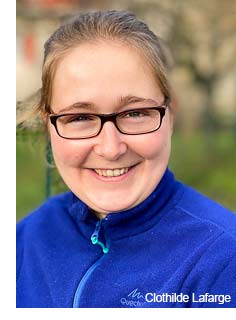 Wednesday 6 November
Wednesday 6 November
More pains au chocolat and a croissant start the day and then we split again. Zoë goes to Domaine Lafarge in Volnay, Neil goes to Dugat-Py and I start the day at Domaine Meo-Camuzet in Vosne-Romanee, where after a chat with Jean-Nicolas in his office we go down into a new cellar extension to taste. The samples have been pre-prepared and bottled and dispensed through coravin. I believe this is less than ideal and reduces the samples to the quality of the London January tastings. So I’m tasting through that filter. Pierre is the cellarmaster and takes us through the morning. There’s a new white from Ladoix, which is pretty impressive and will replace Clos St-Philibert while the latter is being replanted. Vintage comparisons here are with 2015 and 2005 and the alcohol range is between 13 and 14%. Picking for the whites began on 29th August and 4th September for the reds. Meo-Camuzet don’t do whole bunch ferments, though they occasionally add in 10% stems to reduce acidity. Stems contain significant potassium if you think back to O level physics with Chemistry. The reds here are generally super: Clos Vougeot is impressive - it’s considered an awkward Grand Cru; most of the rest have big structures but supple, woven tannins and plenty of flesh. They are perfumed as well and there’s plenty of complexity, so it’s an impressive start to the day.
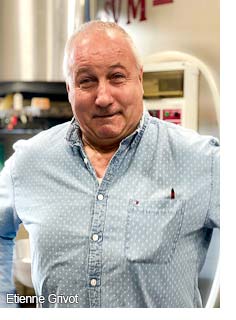 On to Domaine Jean Grivot where we have a quick tour of Etienne’s new terrace, the massive roadworks outside the entrance and some of his art collection. They picked later here, on September 11th, waiting for the rain that fell on the 6th and 7th September to be absorbed by the vines. It’s always interesting here and Etienne emphasised not only how much effort they put into the vines, but how much time and money they put into equipment: purchase and maintenance. He said a lot of growers he knows lost their cooling equipment in the hot vintage conditions because it was too old, and thus also lost control of their ferments. Terroir and fruit quality aside, he said you couldn’t make great wine in a vintage like 2018 without your kit in top condition and good people. They also changed their normal picking pattern, leaving Vosne vineyards until later in the campaign. Alcohols range from 13-14%.
On to Domaine Jean Grivot where we have a quick tour of Etienne’s new terrace, the massive roadworks outside the entrance and some of his art collection. They picked later here, on September 11th, waiting for the rain that fell on the 6th and 7th September to be absorbed by the vines. It’s always interesting here and Etienne emphasised not only how much effort they put into the vines, but how much time and money they put into equipment: purchase and maintenance. He said a lot of growers he knows lost their cooling equipment in the hot vintage conditions because it was too old, and thus also lost control of their ferments. Terroir and fruit quality aside, he said you couldn’t make great wine in a vintage like 2018 without your kit in top condition and good people. They also changed their normal picking pattern, leaving Vosne vineyards until later in the campaign. Alcohols range from 13-14%.
The wines? Lots of terroir differences showing both between the Nuits and Vosne wines but also marked within each village. The samples were fresh decants into carafe from barrels first used for the 2016 vintage. We crescendoed through the premiers and grands crus (amazing actually, since nobody asked, ever) and finished with a Coteaux Bourgignon Gamay. Etienne loves Gamay. He told us that when he was a student he went to a big blind tasting and took a 1949 version made by Henri Jayer’s dad! It punched well above its weight, with people massively overbidding its appellation. He mentioned Musigny…
Domaine Philippe Livera was next, so a quick drive to the back of Gevrey-Chambertin took us to this beautifully maintained Domaine. A proper family Domaine, you get to the cellar through the kitchen where lunch was being prepared. They’ve got vines in Gevrey and Brochon and a little Fixin and destem everything. They began picking on 6th September. I like these wines. They seem genuine and had good acidity and freshness as well as good depth of flavour. We emerged from the cellar to find a full kitchen, the family gathered for lunch and granny about to dish up, so ravenous ourselves we gave thanks and left.
When you’ve spent four hours teasing your tummy by putting tasty things in your mouth but never actually swallowing, hunger pangs take on a new intensity. There’s only one answer in Gevrey: hasten to the Complexe Sportive and hope first for a table - success! Secondly to get your order in before the twenty strong group from Berry Bros. Success there too fortunately. This is a buzzy canteen I’ve written about before and is very efficient and good value as well as being excellent quality. The wine list isn’t wholly accurate but we can live with that. We split again after lunch: Zoë headed south again while Neil and I headed for Domaine Ghislaine Barthod.
I was interested to taste at a Chambolle property. We had great feedback from Francois Bertheau’s wines but so far this week it seems to me that the Chambolles from non-Chambolle producers stood out as being more structured than the rest of their portfolio. They seem to have bigger, even if supple tannins. It’s been like 2005 in Chambolle.
Ghislaine Barthod. First the bad news: she lost 50% of the crop in 2019. The 2018s are quite big wines. She started picking on 26th August and her alcohol levels range from 13-13.6%. Everything here is perfectly ripe, there’s no phenolic bitterness and the textures on these wines are as seductive as you could wish. They’re aromatic, floral and red fruits. They finish on their fruit and silky texture, but they’ll be wines to keep.
Time to hit the motorway again as we get to Domaine Jean-Marc Boillot. Here Lydie started harvest on 27th August for reds and whites. The first four wines up to and including Puligny Referts seem a tad light to me. But I have been spoiled this week! The second half of the tasting is rather better with 1er crus Champs Canet, Truffiere and Les Combettes all showing much finer and more intense. The Batard is open and elegant.
Domaine Marc Colin to finish the day. I must say that now all the family business is settled and Damien and his sister have their 12 hectares to look after he seems more relaxed and more focused. In the last couple of years the wines here have been sculpted and lean. In 2018 words like drive, stuffing, energy, salinity, presence and penetration appear. This is a Domaine on top form. And yes, this Le Montrachet is the best white Grand Cru we taste this week and the Batard probably second best. Damien and Caroline started picking on 1st September.
Dinner is at La Table du Square. This has the advantage of being fairly small and most of all on the wrong side of the ring road, so less infested with wine trade. Yes, I know, the glorious hypocrisy. Anyway, one of my dishes of the year here: a starter of monkfish liver with a fennel and lemon salad. Stunning work. Also some nice wine. And the walk home afterwards is also useful.
Tuesday 5 November
Tuesday morning starts with a pain au chocolat from the rather good boulangerie opposite and subsequently work finds us in three different places. I’m in Chassagne-Montrachet just round the corner from the public loo - it’s a fantastic landmark - at Heitz-Lochardet. This is a relatively recent domaine: in its current incarnation only since 2013. This is the estate that last year excited Neil for its Sauvignon Blanc vineyard. This year it isn’t mentioned so we draw a veil. Burgundy tastings that begin with reds are rare these days but this is one. They have Gamay in their Cote de Beaune and last year bought some land in the Beaujolais Cru village of Julienas. They are super environmentally conscious and started organic and biodynamic conversion but the growth of the estate as they reassemble it from far-flung family holdings made it impossible. They are certainly sustainable and follow a lot of organic practice. Reds and whites are structured but tannins are very fine and the whites mineral and juicy. They started harvest on 27 August.
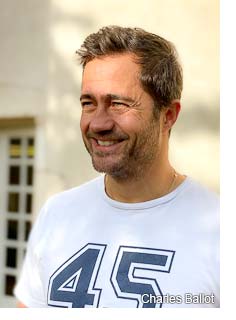 Zoë and Neil start Tuesday at Domaine Ballot-Millot in Meursault, for a blindingly good set of whites. (This despite the pervasive smell of dog poo in the tasting room, courtesy of a fellow merchant having stepped in something unsavoury on the way in). One of the themes of our week is how good many of the whites are, despite our expectations to the contrary. The best growers have utterly defied the ripeness of the vintage to produce whites that are full of energy, vivacity, electricity and life. At Ballot-Millot, Charles’ whites are stunning, possibly the best we taste all week.
Zoë and Neil start Tuesday at Domaine Ballot-Millot in Meursault, for a blindingly good set of whites. (This despite the pervasive smell of dog poo in the tasting room, courtesy of a fellow merchant having stepped in something unsavoury on the way in). One of the themes of our week is how good many of the whites are, despite our expectations to the contrary. The best growers have utterly defied the ripeness of the vintage to produce whites that are full of energy, vivacity, electricity and life. At Ballot-Millot, Charles’ whites are stunning, possibly the best we taste all week.
The next stop was Philippe Colin. This was a most impressive tasting. I‘ve visited here a few times but this was easily the best vintage I’ve tasted from Philippe. He started picking whites on 1st September and reds on 18th and has alcohols between 13.3 and 13.8%. These whites are big and ripe and rich and yet have racy acidity, stony minerality with length and body. In fact they have everything. There is also a large range of difference between the various terroirs. For instance the two Chassagnes from Maltroie and Les Vergers are clearly from different sites.
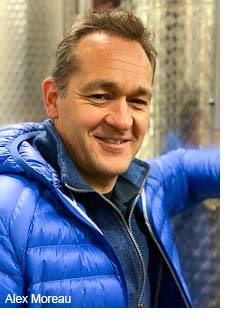 Next to Domaine Bernard Moreau, where we expect nothing but the best, and were rewarded. From the Bourgogne Chardonnay - a must buy every year anyway - all the way to Batard and Chevalier-Montrachet, this was a masterclass of intelligent winegrowing and super judgement. Natural alcohols here range between 12.6 and 13.2 and began harvest on 30th August. Alex thinks there will be a lot of doubting Thomases this vintage, but once they taste they’ll believe. They had a good crop, even from the older vines like in Chenevottes and that will help to even out the losses in 2019. The growing season didn’t present many problems here, except as Alex says, they’ve become like farmers now, always looking for water. His biggest mistake was underestimating the size of the crop and selling too many used barrels. A privilege of a tasting.
Next to Domaine Bernard Moreau, where we expect nothing but the best, and were rewarded. From the Bourgogne Chardonnay - a must buy every year anyway - all the way to Batard and Chevalier-Montrachet, this was a masterclass of intelligent winegrowing and super judgement. Natural alcohols here range between 12.6 and 13.2 and began harvest on 30th August. Alex thinks there will be a lot of doubting Thomases this vintage, but once they taste they’ll believe. They had a good crop, even from the older vines like in Chenevottes and that will help to even out the losses in 2019. The growing season didn’t present many problems here, except as Alex says, they’ve become like farmers now, always looking for water. His biggest mistake was underestimating the size of the crop and selling too many used barrels. A privilege of a tasting.
Back to La Cabane for lunch, not much to report as the menu is exactly the same. Simples. Though I did breathalise myself. I’ve often wondered what effect a morning’s tasting has on a light breakfast and I’m relieved that I don’t seem to have consumed any alcohol. Or at least not enough to show up. I’m not intending to become overconfident.
Off to Pommard and Launay-Horiot: our former fighter pilot. Xavier is an honest and open man, perhaps coming from an aviation background and perhaps it’s just him. He’s very open about still learning. He’s evangelical about what he’s learning. He too underestimated the crop and had to buy a couple of fermentation vats quickly. Like a lot of growers starting without a lot of capital, he leases his barrels. You still have complete control over which cooper, level of toast and so on, but it’s on the right side of the balance sheet. The wines, whether from his Pommard or Cotes de Nuits vineyards have good structure and supple tannins and are floral and mineral and elegant.
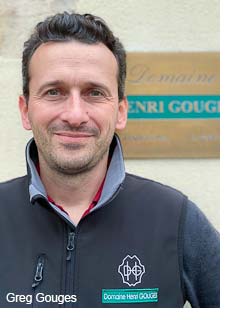 From Pommard it’s up the motorway to Domaine Gouges, old friends and familiar wines. Though Nuits-St-Georges suffered from hail and they lost a fair bit, Greg is smiling because the quality is good. For him 2018 is a blend of 2009 and 2015. Alcohols range between 13.5 and 14.5% but they don’t show it. They began their harvest on 8th September. The wines are very structured and have lots of tannin though they’re very supple. If you’re my age buy village or Pruliers, if you’re young buy Vaucrains; it’s going to be magnificent. Greg generously opened a 99 Vaucrains blind and I reckon this will be at least as great.
From Pommard it’s up the motorway to Domaine Gouges, old friends and familiar wines. Though Nuits-St-Georges suffered from hail and they lost a fair bit, Greg is smiling because the quality is good. For him 2018 is a blend of 2009 and 2015. Alcohols range between 13.5 and 14.5% but they don’t show it. They began their harvest on 8th September. The wines are very structured and have lots of tannin though they’re very supple. If you’re my age buy village or Pruliers, if you’re young buy Vaucrains; it’s going to be magnificent. Greg generously opened a 99 Vaucrains blind and I reckon this will be at least as great.
We split again and I went to Fixin to Berthaut-Gerbet. Here we tasted with some of the giants of the wine trade. Amelie has been experimenting with stems on some of the smaller cuvees. She doesn’t have sufficient space yet for the larger vineyards. She picked white grapes on 31st August and reds started on the 4th September. When she does use (stems) whole bunch, Amelie likes about 30-40%. Her wines are delicious, again with a lot of terroir differentiation. Her Chambolle is one of the best so far - it seems to ve a bit of an outlier at this stage of the week. These are hard to get but worth the effort if you find them.
This is the last evening we manage to get back to the flat before going out to dinner. We go to La Buissonnière in Rue Maufoux, which was excellent. We even had vegetables.
Monday 4 November
Like every Burgundy vintage, the obsession is with the weather. How hot, how dry, how much frost or hail or rain? 2018 was clearly about warmth and dryness. There are no problems achieving ripeness, only various strategies for how to keep it at bay, or at least balance sugar and phenolic ripeness. The latter is when the skins and pips are fully developed and you get no green flavours. One of the themes of the week is how to achieve that phenolic ripeness without massive alcohols.
 Our first visit was to Domaine Julien in Comblanchien; essentially a Nuits St-Georges property. I’ve tasted with Etienne in London a couple of times and liked his wines. He has made a few changes since taking over from his father and is planning more. It’s expensive to buy and maintain good kit, but it can make a lot of difference to the finished wine. He’s been investing in the cellar as he reckons his father is a very good farmer and the vines are in good shape. The next development will be a new destemmer: a crucial bit of equipment that has a big effect on quality. His is 20 years old. There will be a new cellar as well in some other farm buildings. His 2018 wines show a good range between different vineyards. They have good perfume and density on the palate. Yields were low partly because of losses to hail. The maximum alcohol of any of them is 14.5% and the acidity is decent with ph readings averaging 3.65. Good wines.
Our first visit was to Domaine Julien in Comblanchien; essentially a Nuits St-Georges property. I’ve tasted with Etienne in London a couple of times and liked his wines. He has made a few changes since taking over from his father and is planning more. It’s expensive to buy and maintain good kit, but it can make a lot of difference to the finished wine. He’s been investing in the cellar as he reckons his father is a very good farmer and the vines are in good shape. The next development will be a new destemmer: a crucial bit of equipment that has a big effect on quality. His is 20 years old. There will be a new cellar as well in some other farm buildings. His 2018 wines show a good range between different vineyards. They have good perfume and density on the palate. Yields were low partly because of losses to hail. The maximum alcohol of any of them is 14.5% and the acidity is decent with ph readings averaging 3.65. Good wines.
Next to Domaine Jean-Marc Millot, where we met Alix. We’ve been here before and were impressed by Alix, who is as impressive a winegrowing brain as any of her generation. She also lost around 40% of the crop to hail and her average alcohol was 13.5%. She started picking on 2 September and like Etienne Julien has mostly changed cellar work. In 2018 they deployed a new sorting table and destemmer, which she thinks has improved the wine. She only buys barrels with a very light toast as she doesn’t want overt influence on what are quite delicate wines. Together with a fairly high proportion of older vines you have complexity and depth even at this stage. Alix highlighted the difficulties some people had in the cellar in 2018, particularly regrading the fermentations. With the grapes coming in so warm, some ferments stuck and conflicted. What does this mean?
Ideally, when grapes arrive in a cellar the alcoholic fermentation starts naturally or is kickstarted with cultured yeast. After this is finished the malolactic conversion starts. This converts any malic acid into lactic, hence the name, but it also processes many other bacteria and renders them harmless. Your wine, if things happen in that order, is now microbiologically much more stable and for most of our growers this will be the first stage when they might think about adding sulphites, though many don’t yet. In 2018 some growers had problems with the malolactic completing before the alcoholic; rendering their wines vulnerable to problems later.
The wines at Domaine Millot were harmonious, perfumed and with fine tannins.
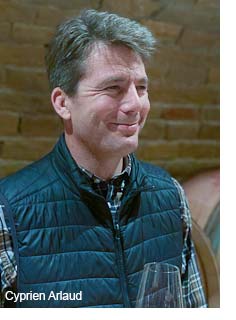 Back to Beaune and to Europcar, who were incredibly helpful, getting us on the road: essential because we were due to split up later in the afternoon. Thanks very much to them.
Back to Beaune and to Europcar, who were incredibly helpful, getting us on the road: essential because we were due to split up later in the afternoon. Thanks very much to them.
Going south we snatched a quick lunch in Chassagne-Montrachet at La Cabane, which is a curious, almost temporary-looking structure. You can find it by following signs to the village public loo, which it shares. Really good soup, chicken and chips.
Now to Meursault to see Arnaud and Catherine Tessier. As ever Arnaud is busy finishing the new cellar extension so after welcoming us and a quick chat about the vintage it’s off to the barrel room to taste. With white wines in a warm vintage some of the challenges are different. In many warm countries acidification of wines is normal but at Tessier they don’t go in for it. They believe that wines that have been artificially acidified won’t age well. They are uncertified organic, no herbicides at all, only organic treatments otherwise and they use one or two biodynamic techniques as well. The wines are juicy, structured and balanced with fine textures.
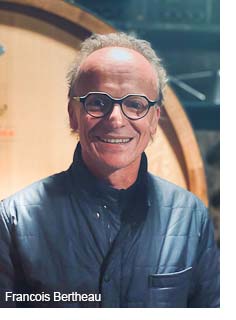 Now we split, Zoë is off to Domaine Bertheau in Chambolle-Musigny, to find a whimsical Francois who is only interested in teasing his visitors and not talking about wine. But they are very good. I’m away to Morey-St-Denis to see Cyprien Arlaud at his eponymous domaine. For Cyprien it was a difficult year, but he felt that having been biodynamic for 15 years his vines coped well, especially the old ones. His regime has pushed the roots down and hydric stress wasn’t such an issue. He did have to keep a close eye on the ferments but got through without real issues. The wines were super, good structure but well extracted and with fine structure and again, good flavours and textures. We tasted the differences between the different vineyards very well.
Now we split, Zoë is off to Domaine Bertheau in Chambolle-Musigny, to find a whimsical Francois who is only interested in teasing his visitors and not talking about wine. But they are very good. I’m away to Morey-St-Denis to see Cyprien Arlaud at his eponymous domaine. For Cyprien it was a difficult year, but he felt that having been biodynamic for 15 years his vines coped well, especially the old ones. His regime has pushed the roots down and hydric stress wasn’t such an issue. He did have to keep a close eye on the ferments but got through without real issues. The wines were super, good structure but well extracted and with fine structure and again, good flavours and textures. We tasted the differences between the different vineyards very well.
Finally I went to Vosne-Romanee, to Georges Noellat and Max. The wines here are in his image, big frames and flesh on the bones. He’s a confident young man and for him it was an easy vintage. He worked hard in the vineyard to ensure the grapes weren’t too sugary and he didn’t have too high alcohols. In the cellar he extracted early and quickly to get the red fruit and he compares the vintage to 1999. The colours are dark on these wines - almost opaque purply-black on some but they’re heterogeneous, again demonstrating terroir difference. Different from anything else I tasted later in the week. Max thinks the wines will be perfect in 10-15 years. A very interesting snapshot of the vintage. That’s day one and only just over 50 wines tasted.
Dinner at La Popiette, a restaurant we hadn’t been to before, it’s bright and breezy with good food and a decent list.